The zonal isolation market, valued at USD 20.3 billion in 2020 and projected to reach USD 43.5 billion by 2035, is advancing at a steady CAGR supported by evolving energy exploration and drilling practices. From 2020–2025, the market grows from USD 20.3 billion to USD 26.2 billion, representing the early adoption phase where conventional cementing solutions dominate as cost-effective and widely used methods in oil and gas wells. This stage is analogous to traditional hydraulic systems, with reliable but less sophisticated performance. Between 2025–2030, the market expands from USD 26.2 billion to USD 33.8 billion, marking a scaling phase fueled by offshore exploration, deeper well drilling, and stricter regulatory emphasis on well integrity.
From 2030–2035, the market consolidates and reaches USD 43.5 billion, reflecting a shift toward integrated zonal isolation systems with predictive monitoring, smart sensors, and adaptive sealing capabilities, which can be compared to EPS-like advanced technologies in other industries.
Growth during this phase is led by premium applications in ultra-deepwater projects, unconventional reserves, and geothermal wells. Emerging regions show strong adoption driven by new field development, while mature markets witness upgrades in aging infrastructure to comply with environmental standards. The industry maturity curve shows a sigmoid progression, beginning with traditional cementing methods, transitioning to advanced elastomer and composite solutions, and moving toward intelligent zonal isolation systems with long-term wellbore integrity as a priority.
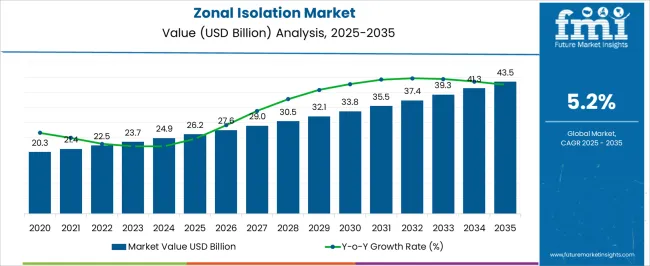
| Metric | Value |
|---|---|
| Zonal Isolation Market Estimated Value in (2025 E) | USD 26.2 billion |
| Zonal Isolation Market Forecast Value in (2035 F) | USD 43.5 billion |
| Forecast CAGR (2025 to 2035) | 5.2% |
The zonal isolation market is expanding steadily, driven by the critical need to ensure well integrity and prevent fluid migration during oil and gas extraction. Increasing drilling activities in onshore fields have elevated the demand for reliable zonal isolation solutions.
Industry advancements in well completion technologies and stringent safety regulations have reinforced the importance of effective isolation methods. The focus on reducing environmental risks and enhancing operational efficiency has encouraged adoption of advanced zonal isolation techniques.
Investments in mature onshore fields require remediation and enhanced isolation solutions to optimize production and extend well life. The market outlook remains positive as exploration and production activities increase globally. Segmental growth is anticipated to be led by the onshore application segment and the mechanical method segment, reflecting preferences for durable and proven isolation solutions.
The zonal isolation market is segmented by application, method, and geographic regions. By application, the market is divided into onshore and offshore. By method, it is classified into mechanical and chemical. By region, the zonal isolation industry is categorized into North America, Latin America, Western Europe, Eastern Europe, Balkan & Baltic Countries, Russia & Belarus, Central Asia, East Asia, South Asia & Pacific, and the Middle East & Africa.
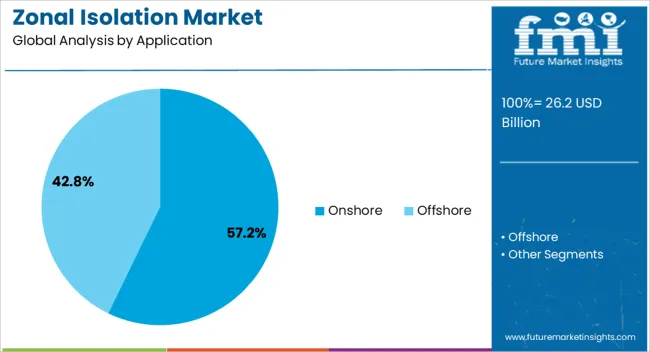
The onshore application segment is projected to contribute 57.2% of the zonal isolation market revenue in 2025, maintaining its position as the leading application area. This segment’s growth is fueled by the extensive onshore drilling and production operations worldwide.
Onshore wells often present unique geological challenges that require effective zonal isolation to prevent crossflow and maintain reservoir integrity. The ease of access and established infrastructure in onshore regions have supported the deployment of zonal isolation technologies at scale.
Moreover, regulatory frameworks focusing on environmental protection have driven operators to prioritize well integrity solutions in onshore fields. As onshore production remains a cornerstone of the oil and gas sector, demand for zonal isolation in this segment is expected to continue growing.
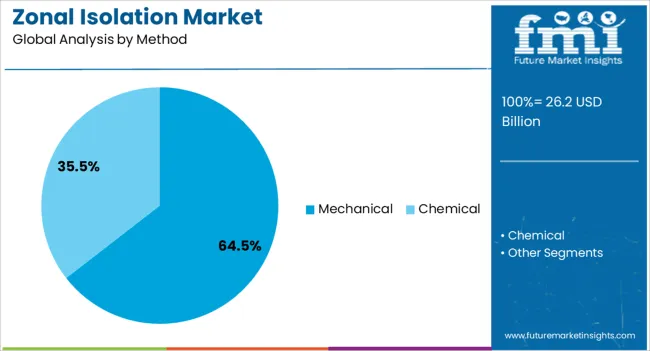
The mechanical method segment is projected to hold 64.5% of the zonal isolation market revenue in 2025, positioning it as the preferred isolation technique. Mechanical zonal isolation involves the use of packers, plugs, and other hardware to physically separate reservoir zones.
This method has been favored for its reliability, ease of installation, and ability to withstand challenging downhole conditions. The segment’s growth is supported by technological improvements in packer designs that offer enhanced sealing performance and durability.
Operators have increasingly preferred mechanical methods for their reusability and adaptability in complex well architectures. With growing emphasis on reducing operational risks and improving well longevity, the mechanical isolation segment is expected to maintain its market dominance.
The zonal isolation market is being driven by regulatory standards, unconventional resource development, material innovation, and the growing demand for well integrity assurance. Its importance continues to expand as operators focus on safety, efficiency, and reliable production outcomes.
The zonal isolation market has gained momentum due to the growing emphasis on ensuring long-term well integrity across oil and gas operations. Effective isolation prevents cross-flow between different formations, protects freshwater zones, and ensures optimal hydrocarbon recovery. The rise in complex drilling environments, such as deepwater and high-pressure wells, has made reliable isolation technologies indispensable. Cementing techniques, packers, and advanced plugging systems are increasingly deployed to mitigate risks of leakage or wellbore collapse. Regulatory authorities have imposed stricter requirements for cement bond evaluation and barrier verification, pushing operators to adopt advanced solutions. This rising focus on operational safety, regulatory compliance, and environmental risk mitigation continues to strengthen the role of zonal isolation in modern energy exploration.
Unconventional resource development has become a central factor boosting demand for zonal isolation solutions. Shale gas, tight oil, and coalbed methane reserves require multi-stage hydraulic fracturing, where reliable zonal barriers are critical. Tools such as swellable packers and composite bridge plugs have witnessed greater uptake in these formations, as they enable efficient fracturing across different zones. Operators are investing in advanced sealing and cementing technologies to maximize recovery rates while avoiding costly remediation. The growing production share from unconventional reservoirs across North America, Asia Pacific, and parts of Europe has reinforced this trend. With companies striving to improve efficiency in horizontal drilling, zonal isolation technologies have emerged as a cornerstone in achieving production targets and reducing operational failures.
The market has been shaped by ongoing improvements in packer materials, cement additives, and plugging devices that enhance performance across challenging environments. Elastomers and composite-based packers offer improved resistance to extreme temperature and pressure conditions, while self-healing cements provide reliable long-term sealing. These innovations reduce the risks associated with traditional isolation methods, where cement shrinkage or packer failure could compromise well integrity. Intelligent packer systems capable of monitoring wellbore conditions are being tested to provide operators with real-time assurance of barrier performance. This shift toward durable, adaptive, and high-performing materials reflects the industry’s preference for tools that can operate reliably in diverse geologies, ranging from offshore ultra-deepwater projects to unconventional resource basins worldwide.
Stringent regulations have placed zonal isolation technologies under greater scrutiny, with authorities mandating more thorough verification of cement bonding and wellbore integrity. Oil spills, well blowouts, and cross-contamination incidents in the past have amplified the focus on environmental safety, requiring operators to adopt advanced solutions. Governments and regulatory agencies have set higher standards for well abandonment procedures, compelling firms to ensure permanent isolation through long-lasting sealing techniques. Environmental concerns have also led to increased monitoring of plug and abandonment operations, especially in offshore projects. Companies offering proven and certified zonal isolation solutions have gained preference among operators. This regulatory-driven demand acts as a consistent catalyst, ensuring that zonal isolation remains an indispensable segment in the oilfield services sector.
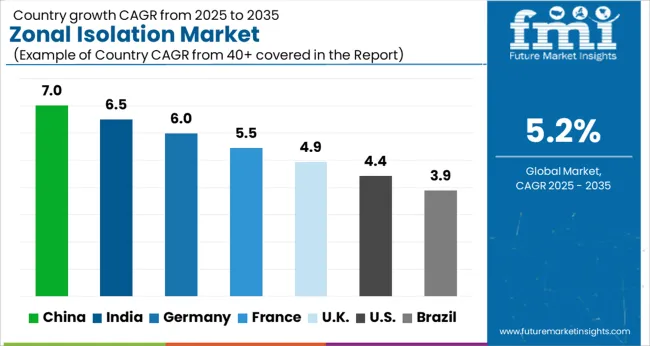
The zonal isolation market is projected to grow globally at a CAGR of 5.2% from 2025 to 2035, with China leading at 7.0%, supported by extensive drilling programs, unconventional resource development, and large-scale offshore projects. India follows at 6.5%, driven by expanding exploration in deepwater basins, rising energy demand, and government-backed upstream investments. France records 5.5% growth, influenced by offshore operations and adherence to strict well integrity standards. The UK posts a 4.9% CAGR, shaped by North Sea activities and increasing regulatory focus on safe abandonment practices. The USA shows a 4.4% growth rate, reflecting a mature oilfield environment where zonal isolation demand is tied to well intervention, plug and abandonment projects, and selective unconventional resource developments.
The CAGR for the zonal isolation market in China was estimated at 6.2% during 2020–2024 and improved to 7.0% in the 2025–2035 period. This upward trajectory is driven by the country’s focus on expanding unconventional hydrocarbon projects, deepwater drilling, and ultra-deepwater developments. Investments in advanced cementing techniques, high-performance packers, and durable sealing systems have helped operators reduce failure risks and ensure well integrity. National oil companies are leading in adopting innovative solutions to enhance hydrocarbon recovery efficiency. This strong emphasis on energy security and production optimization has firmly positioned China as a dominant contributor to global zonal isolation demand.
The CAGR for the zonal isolation market in India was 5.7% during 2020–2024 and is expected to rise to 6.5% between 2025–2035. The growth improvement is supported by strong energy demand and expanding drilling operations in deepwater and unconventional basins. Increasing adoption of multi-stage fracturing, horizontal drilling, and advanced packers has significantly strengthened zonal barrier requirements. Both private and state-owned energy companies have prioritized cementing additives and well integrity tools to prevent costly leakages. Government-driven exploration initiatives and upstream reforms have created a favorable environment for adoption. India’s steady growth in energy exploration makes zonal isolation solutions an essential part of its upstream operations.
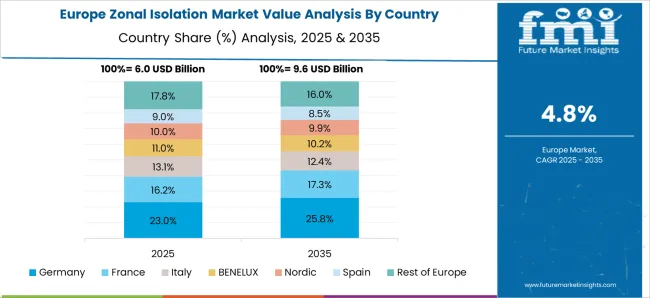
The CAGR for the zonal isolation market in France stood at 5.0% during 2020–2024 and increased to 5.5% for the 2025–2035 timeline. This rise has been supported by offshore exploration in the Mediterranean and North Sea-related projects, where reliable well integrity tools are crucial. Stricter abandonment requirements have pushed operators toward permanent sealing solutions and advanced cement additives. French companies have focused on regulatory compliance and technological adoption to reduce operational risk. While smaller than Asian counterparts, France has carved a consistent niche, with growth anchored in environmental compliance, offshore commitments, and targeted investments in reliable cementing and packer systems.
The CAGR for the zonal isolation market in the United Kingdom was 4.3% during 2020–2024 and improved to 4.9% during 2025–2035. This increase is linked to growing decommissioning work in the North Sea, where plug and abandonment projects rely heavily on durable cementing and isolation technologies. Mature field interventions continue to shape demand as operators deploy self-healing cements and composite plugs. Although exploration activity has slowed, regulatory-driven requirements for well closure have maintained steady growth. The emphasis on safe abandonment practices and long-term well integrity ensures consistent adoption of zonal isolation solutions in the region.
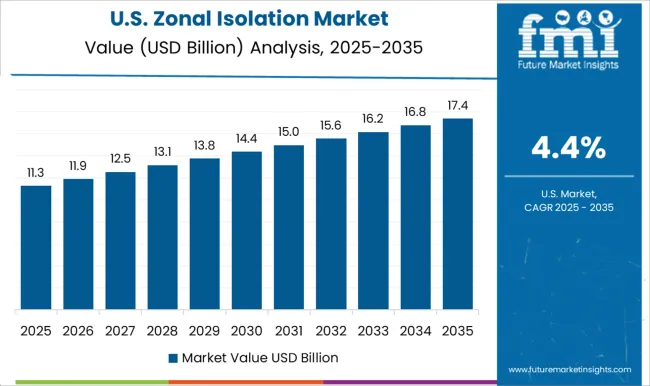
The CAGR for the zonal isolation market in the United States was 4.0% during 2020–2024 and is projected to rise slightly to 4.4% between 2025–2035. The growth is supported by steady shale basin drilling in regions such as the Permian and by regulatory oversight on abandonment projects. Operators have embraced new plug technologies and cement additives to enhance reliability in mature wells and interventions. Despite being a mature oilfield market, the USA continues to drive demand through re-completion projects and unconventional well programs. Its growth remains steady, with long-term well integrity requirements ensuring consistent reliance on zonal isolation.
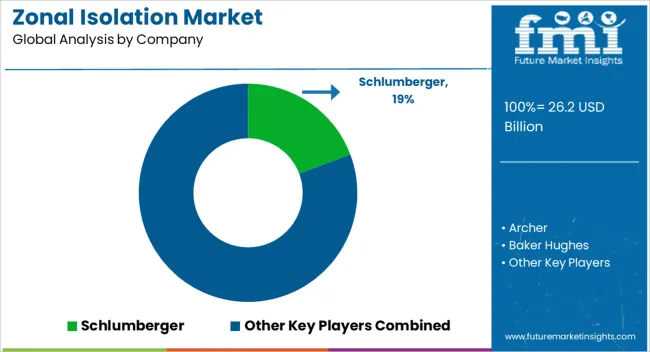
Schlumberger, Baker Hughes, and Halliburton dominate through their comprehensive portfolios of cementing services, packers, and advanced isolation tools designed for both conventional and unconventional wells.
Weatherford also holds a strong presence with its expertise in cement additives and expandable packer solutions. Companies such as NOV and Expro contribute with specialized equipment and services that support efficient drilling and wellbore isolation. Superior Energy Services, Archer, and Trican are known for their regional strengths in pressure pumping and cementing operations, supporting reliable zonal barriers.
TAM International and Welltec have carved niche leadership through advanced mechanical packers and intervention technologies tailored for complex reservoirs. Helix Energy Solutions and Omega Well Intervention specialize in offshore and subsea well integrity solutions, reinforcing the market’s focus on safe operations in high-risk environments.
| Item | Value |
|---|---|
| Quantitative Units | USD 26.2 Billion |
| Application | Onshore and Offshore |
| Method | Mechanical and Chemical |
| Regions Covered | North America, Europe, Asia-Pacific, Latin America, Middle East & Africa |
| Country Covered | United States, Canada, Germany, France, United Kingdom, China, Japan, India, Brazil, South Africa |
| Key Companies Profiled | SLB (Schlumberger), Archer, Baker Hughes, Calfrac Well Services, Expro, Halliburton, Helix Energy Solutions, Hunting Energy Services, HydraWell (Hydra Well Intervention), NOV, Omega Well Intervention, Superior Energy Services, TAM International, Trican, Weatherford, Wellcem, Welltec. |
| Additional Attributes | Dollar sales, share, regional demand trends, competitive positioning, regulatory impact, technology adoption rates, pricing benchmarks, and end-user drilling preferences. |
The global zonal isolation market is estimated to be valued at USD 26.2 billion in 2025.
The market size for the zonal isolation market is projected to reach USD 43.5 billion by 2035.
The zonal isolation market is expected to grow at a 5.2% CAGR between 2025 and 2035.
The key product types in zonal isolation market are onshore, offshore, _shallow, _deep and _ultra-deep.
In terms of method, mechanical segment to command 64.5% share in the zonal isolation market in 2025.






Full Research Suite comprises of:
Market outlook & trends analysis
Interviews & case studies
Strategic recommendations
Vendor profiles & capabilities analysis
5-year forecasts
8 regions and 60+ country-level data splits
Market segment data splits
12 months of continuous data updates
DELIVERED AS:
PDF EXCEL ONLINE
RNA Isolation and Enrichment Reagent Market
Cell Isolation Market Size and Share Forecast Outlook 2025 to 2035
Galvanic Isolation Market - Trends & Forecast 2025 to 2035
Vibration Isolation System industry Analysis in India - Size, Share, and Forecast Outlook 2025 to 2035
Cosmid DNA Isolation Market
Power Supply Isolation Equipment Market Size and Share Forecast Outlook 2025 to 2035
Nucleic Acid Isolation and Purification Market Analysis by DNA Extraction and Purification Kits and RNA Extraction and Purification Kits Through 2035
Protein Purification and Isolation Market Insights – Size, Share & Forecast 2025 to 2035
Bonding Honeycomb Vibration Isolation Platform Market Size and Share Forecast Outlook 2025 to 2035

Thank you!
You will receive an email from our Business Development Manager. Please be sure to check your SPAM/JUNK folder too.
Chat With
MaRIA